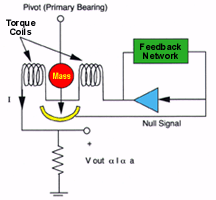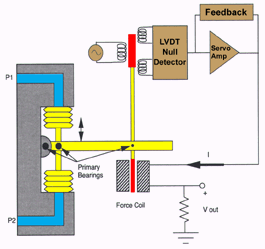Force-balance
(Servo) Sensors
The force-balance
accelerometer is shown below where a pendulous, high-magnetic
permeability mass is hung from a hinge as shown. The "down"
or "null position" is detected by the null detector
and the counterbalancing force is provided by a magnetic coil.

The
Servo Accelerometer
If acceleration
is applied to this assembly, a force is exerted on the mass and
it will attempt to move from the null position. When the null
detector detects motion, the coil current is increased by means
of a servo amplifier to maintain the null position.

The coil current
provides the restoring force required to maintain the null position
and this current will be in direct proportion to the applied
acceleration.
Highly-precise
null detectors can be easily fabricated as the total range of
this deflection is extremely small, in fact, increasing null
detector resolutions will result in proportionately improved
acceleration resolution. Since the active member of the force-balance
accelerometer does not substantially displace in normal operation,
the hysteresis performance of this type of sensor is extremely
low and is due more to electrical hysteresis in the circuitry
than to actual mechanical hysteresis. Damping of the seismic
assembly is accomplished both electrically and mechanically with
silicone oil.
The servo accelerometer
is physically large relative to strain gauge accelerometers but
provides microgravity resolution with high zero-hertz stability
and low thermal errors. The large size of the inertial mass results
in large forces during high shock events, and even though overrange-ilmiting
stops may be incorporated, this type of sensor is not suited
to high shock environments.
Early force balance sensors were provided with piezoelectric
or magnetic "dithering" mechanisms to reduce stiction
effects by constantly oscillating the bearing slightly to keep
the coefficient of bearing friction in the lower dynamic range.
Recent designs, utilizing high-resolution null detect systems,
eliminate the bearing altogether replacing it with a simple quartz
flexure. The superb mechanical characteristics of crystalline
quartz, used as a pivot, provides essentially-zero hysteresis
performance due to the fact that the mass does not deflect significantly.
The typical
useful flat (±5%) frequency response bandwidth of the
servo accelerometer is generally less than 100 Hertz. Based upon
a closed-loop control network, recovery time of a servo accelerometer
from an overrange input can be lengthy relative to the strain-gaged
open-loop accelerometer designs. In fact, the recovery time of
the sensor, after an over-ranged input, is a direct function
of the total power available to the restoring force mechanism.
Typical force balance sensors are usually current-limited to
50 or 100 ma of input drive current thus "energy limiting"
the restoring force mechanism resulting
in typical overrange recovery times of 100 milliseconds.

The large thermal
mass of this sensor type renders the device reasonably insensitive
to thermal transients.

The Servo
or Force-balanced Pressure Sensor
The diagram
shows how the servo force-balance concept can be applied to fabricate
extremely-high-precision pressure sensors based upon the above
concepts. The force-balance pressure sensor is generally large,
and typically not suited to dynamic pressure measurements or
physically-hostile environments, but is admirably suited to the
high-precision and high-resolution measurement of pressure in
more benign physical environments.

This article is taken
from the Handbook
'The Art of Practical and Precise Strain Based Measurement' by
James Pierson

